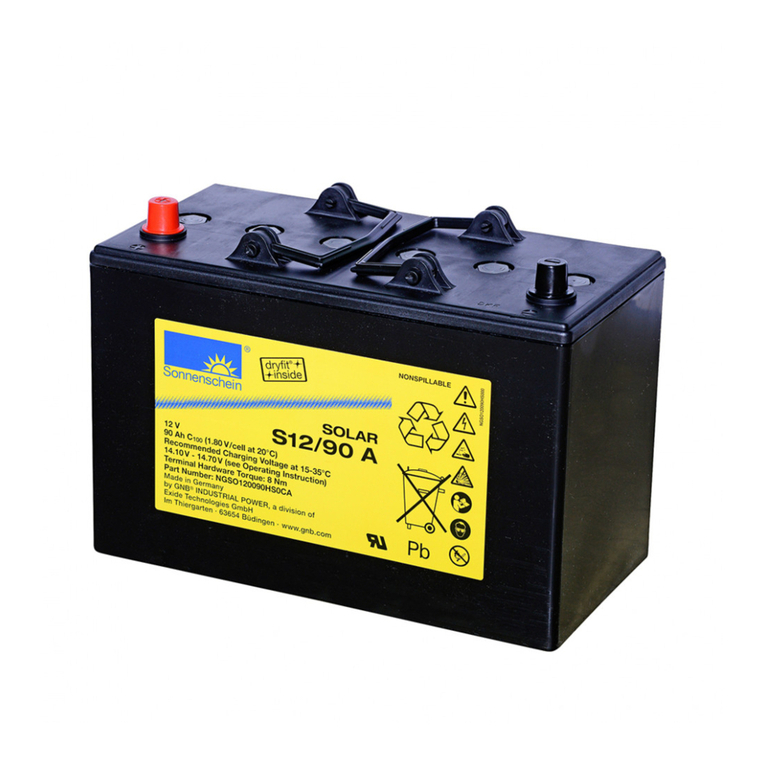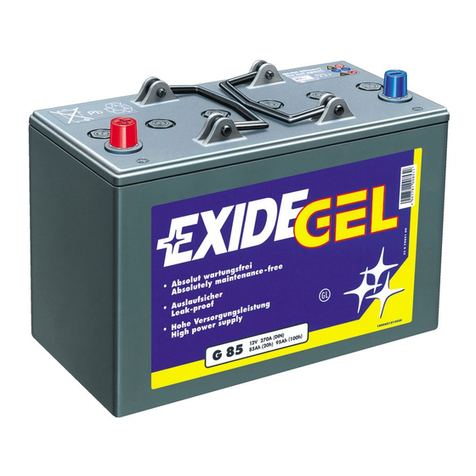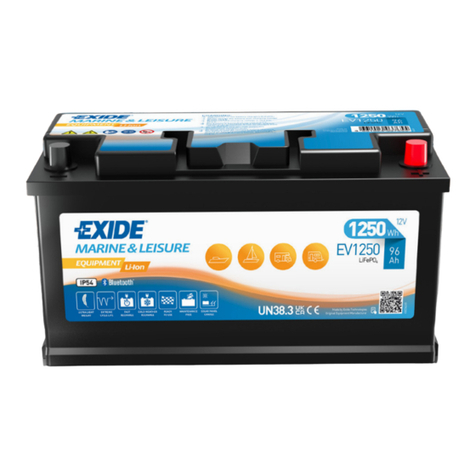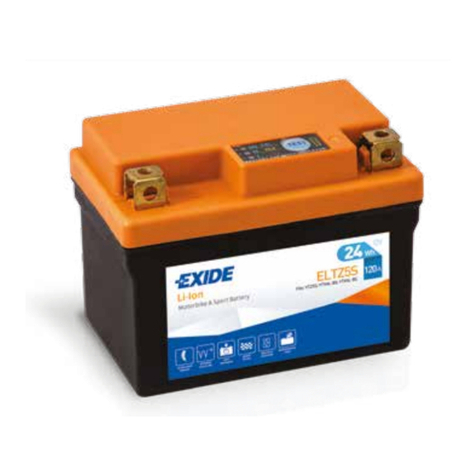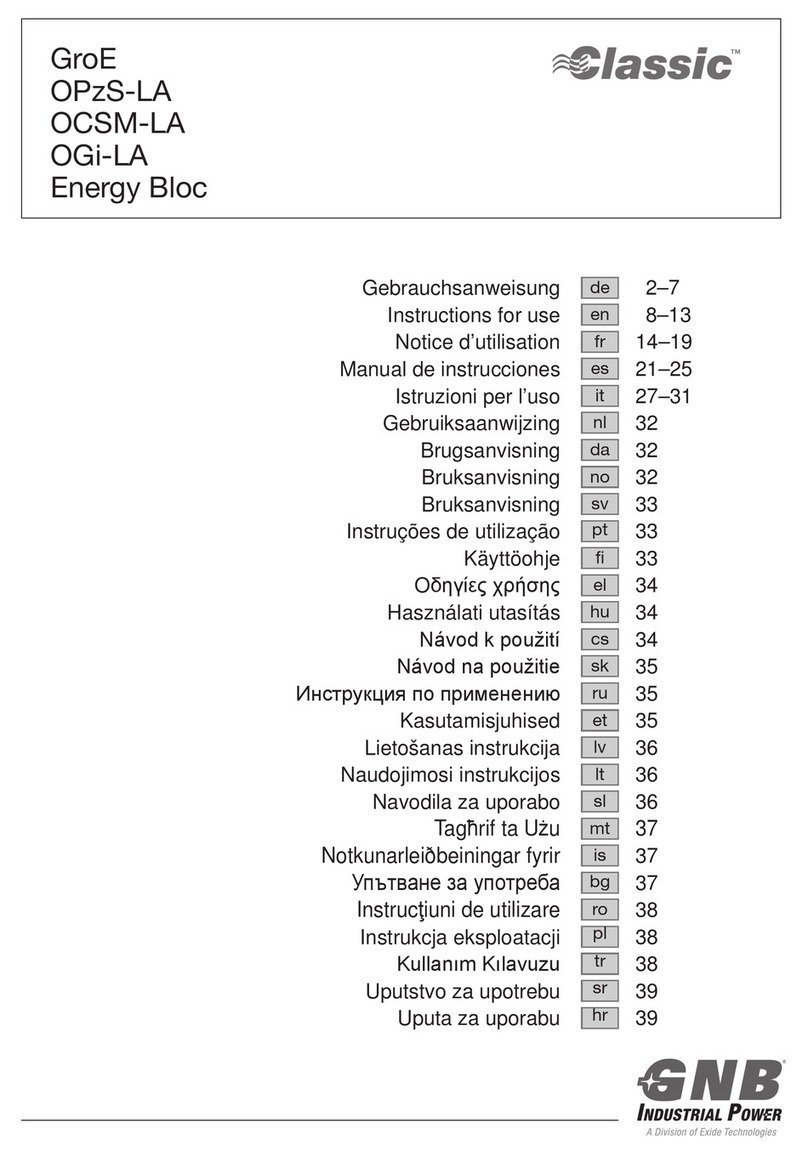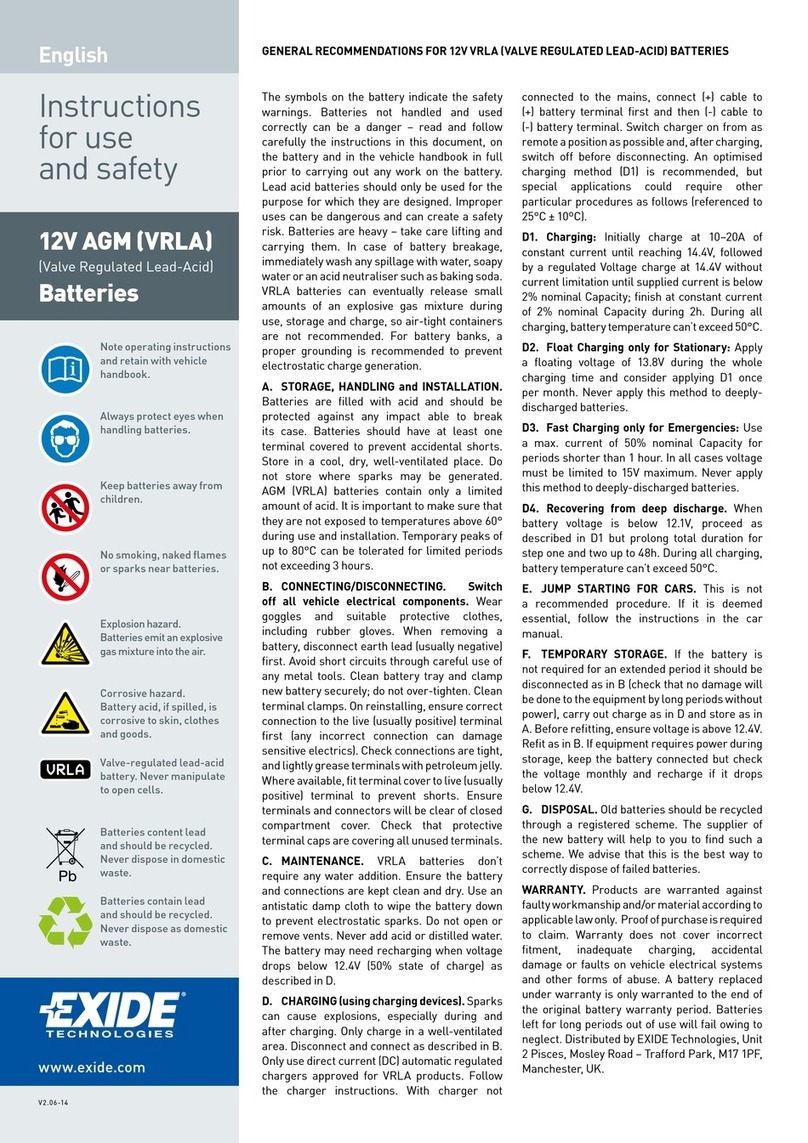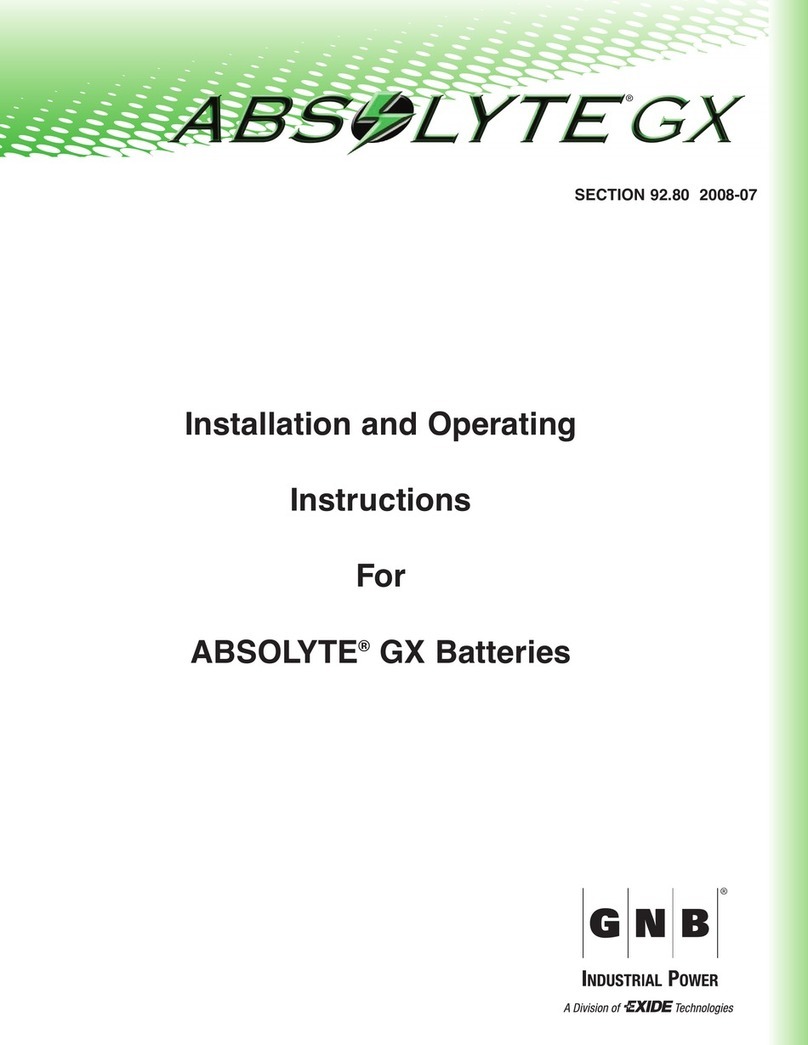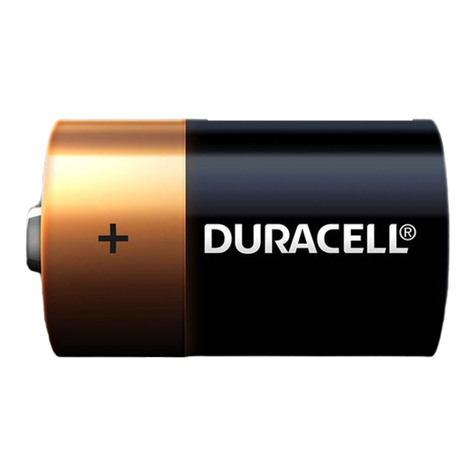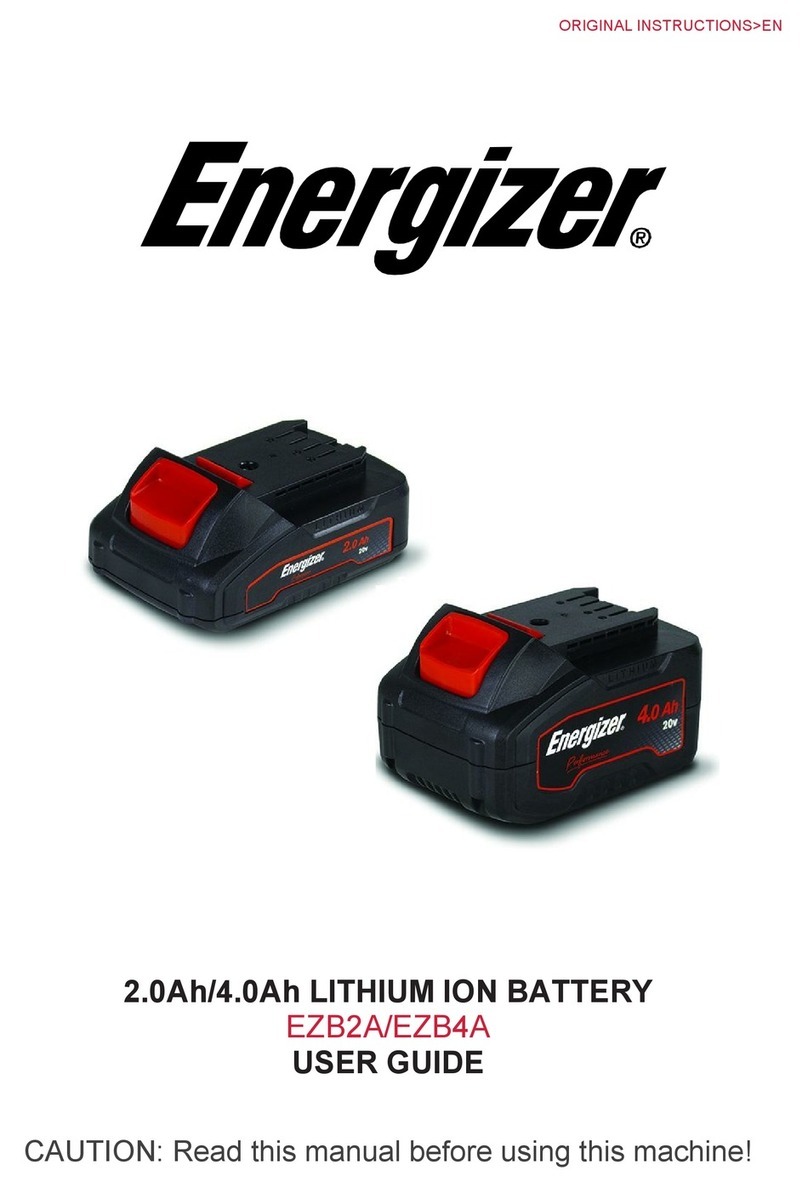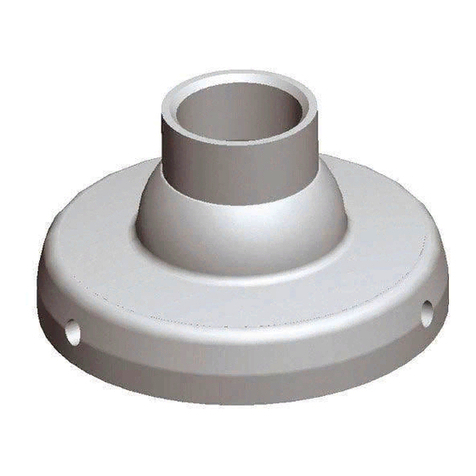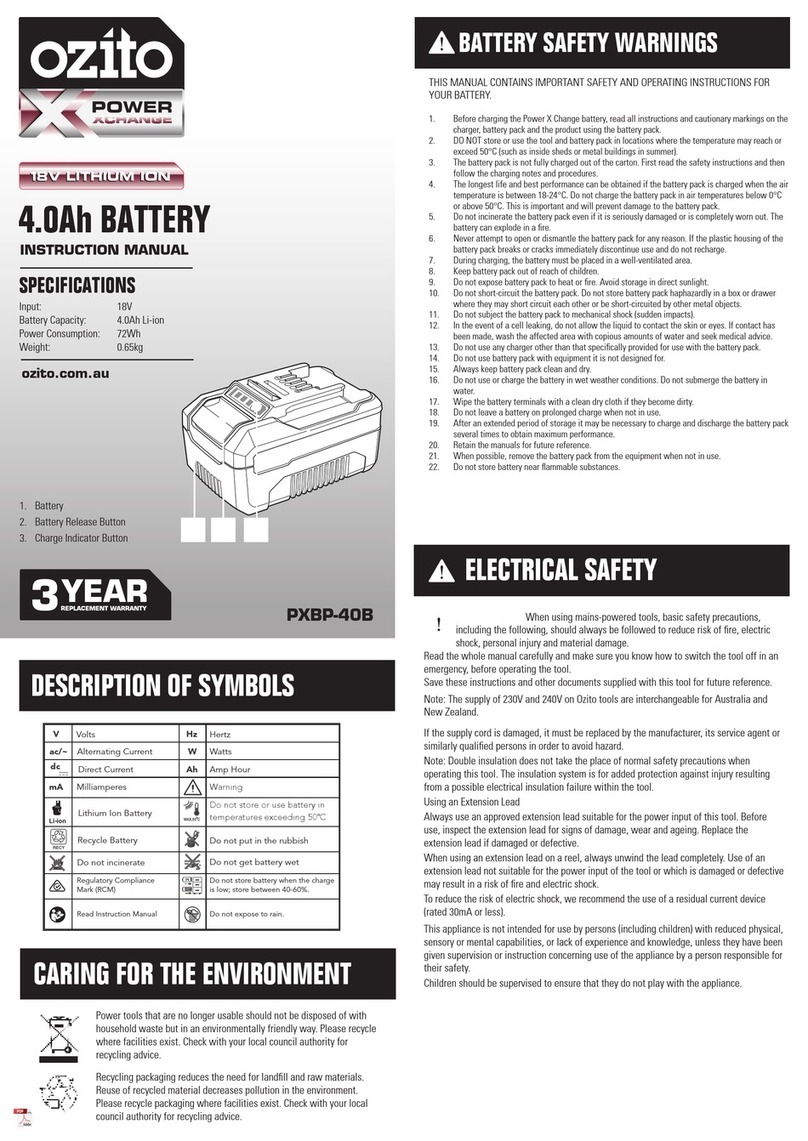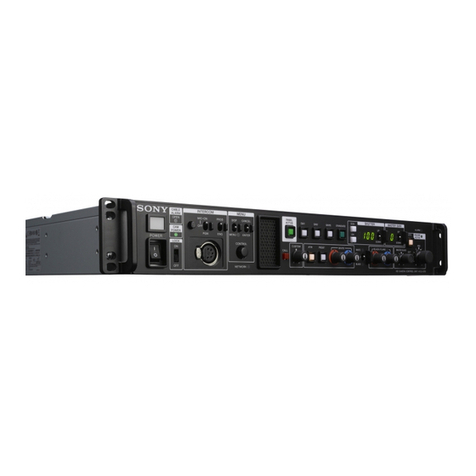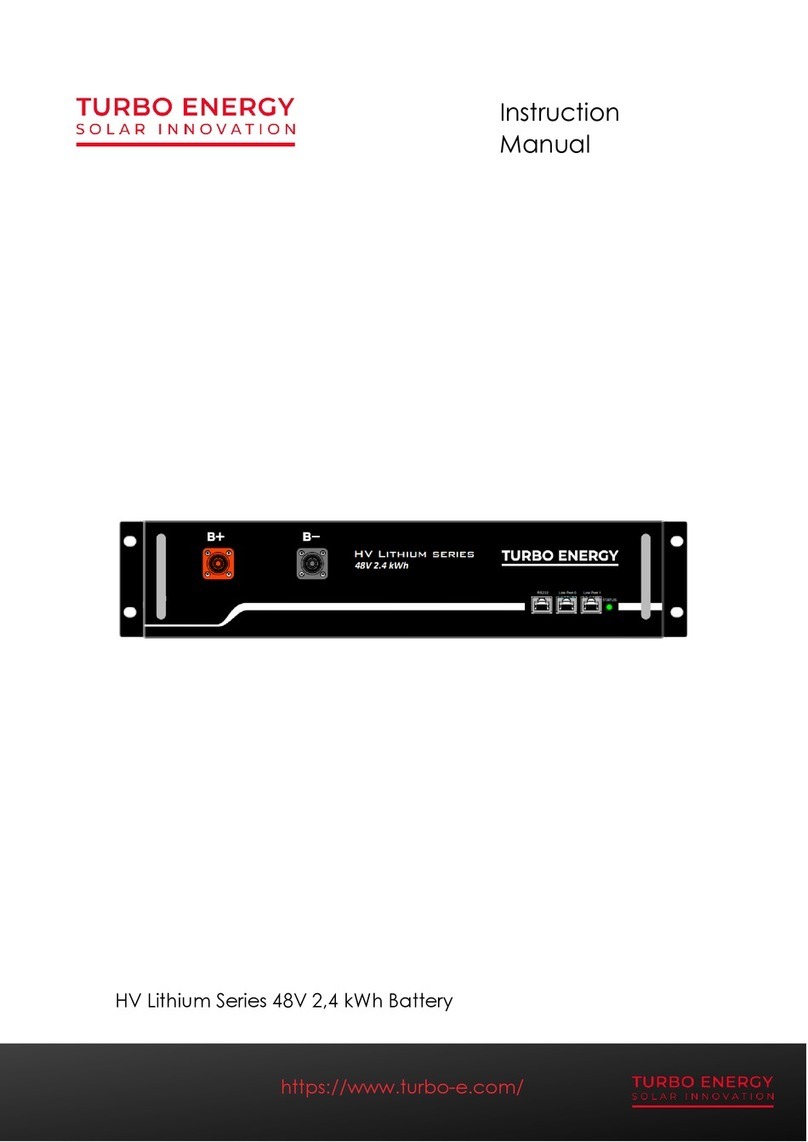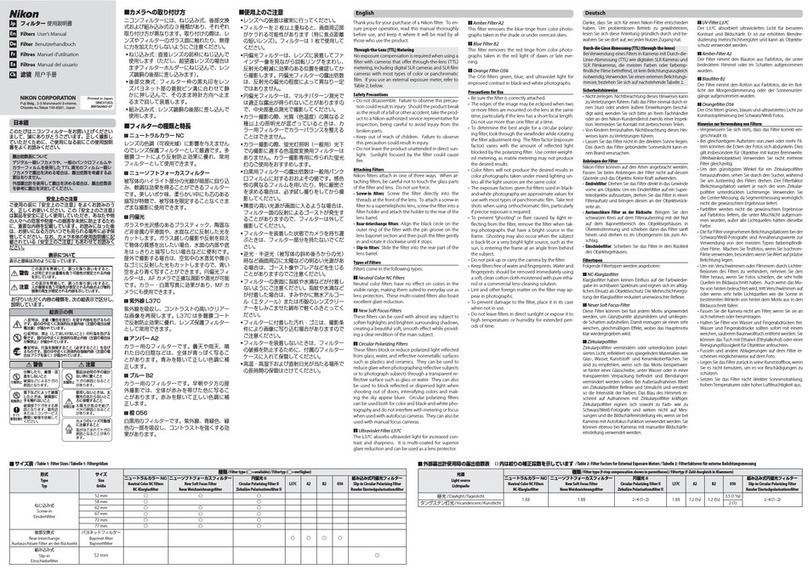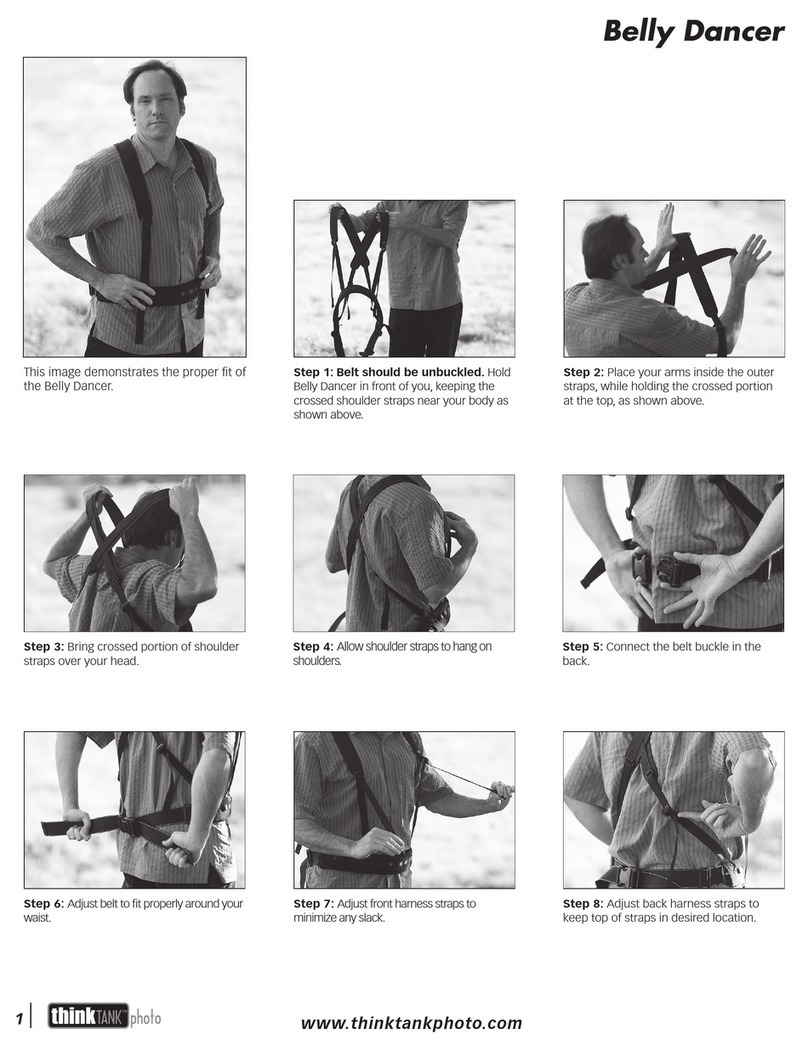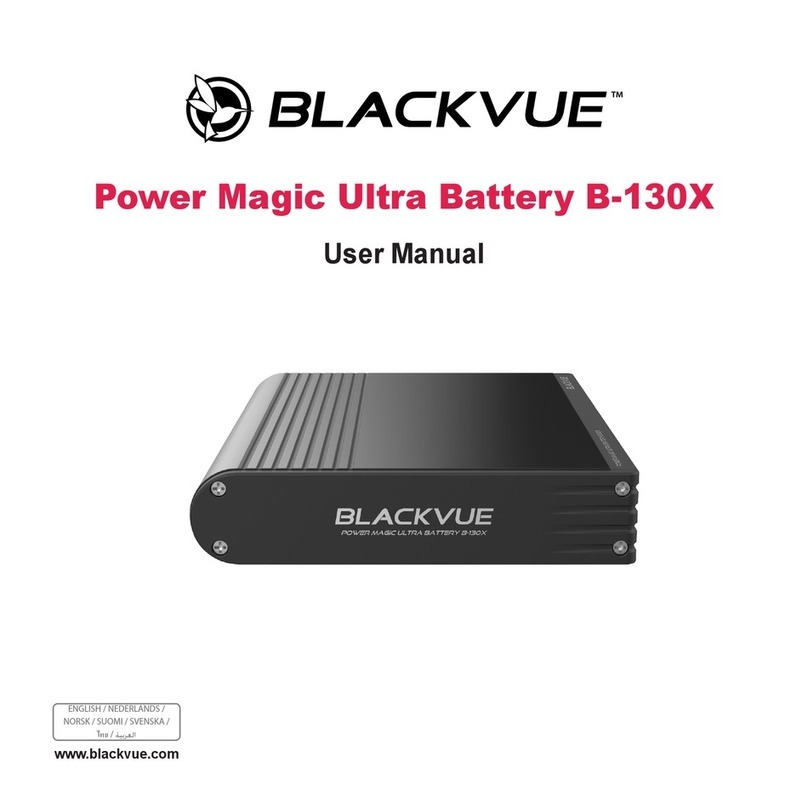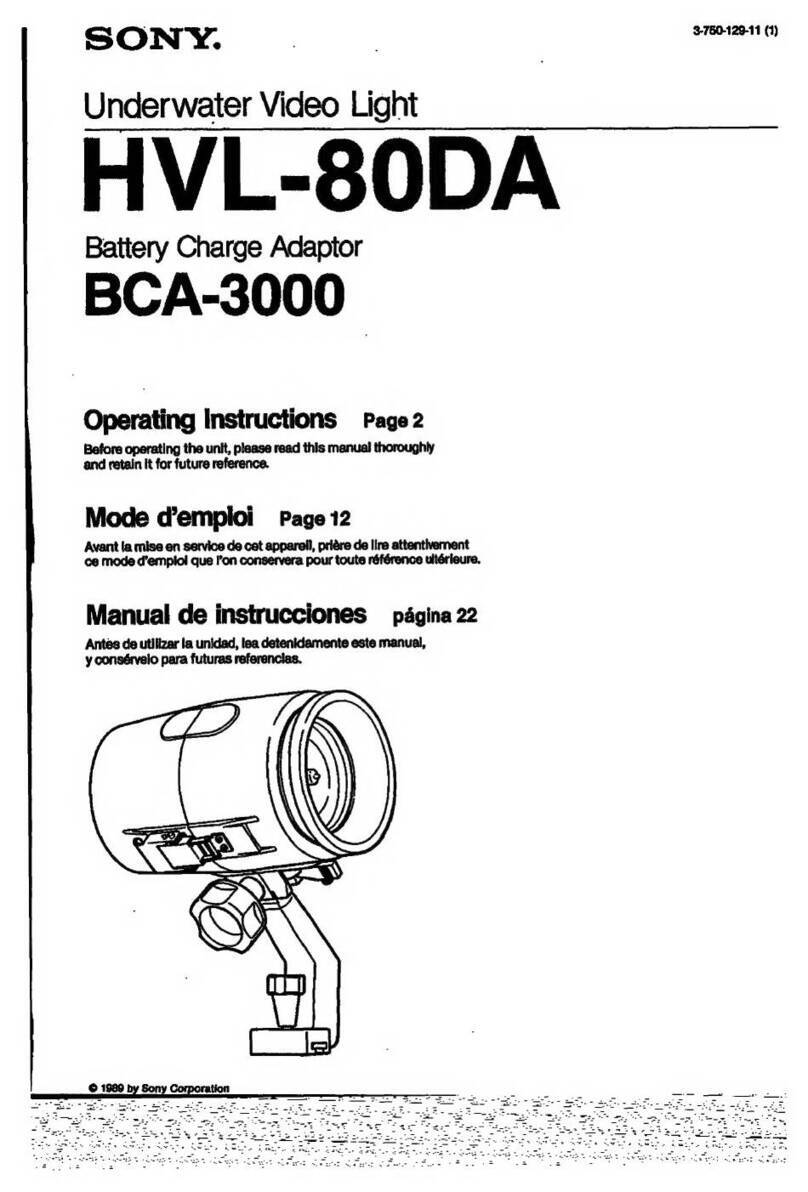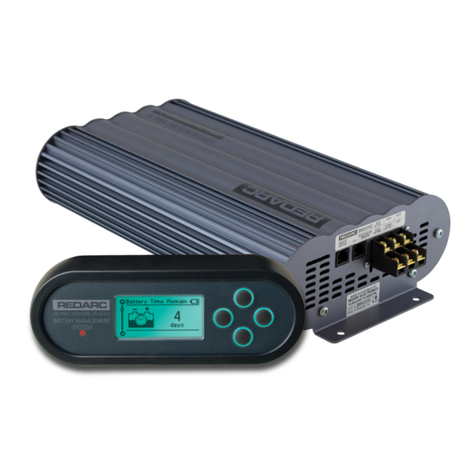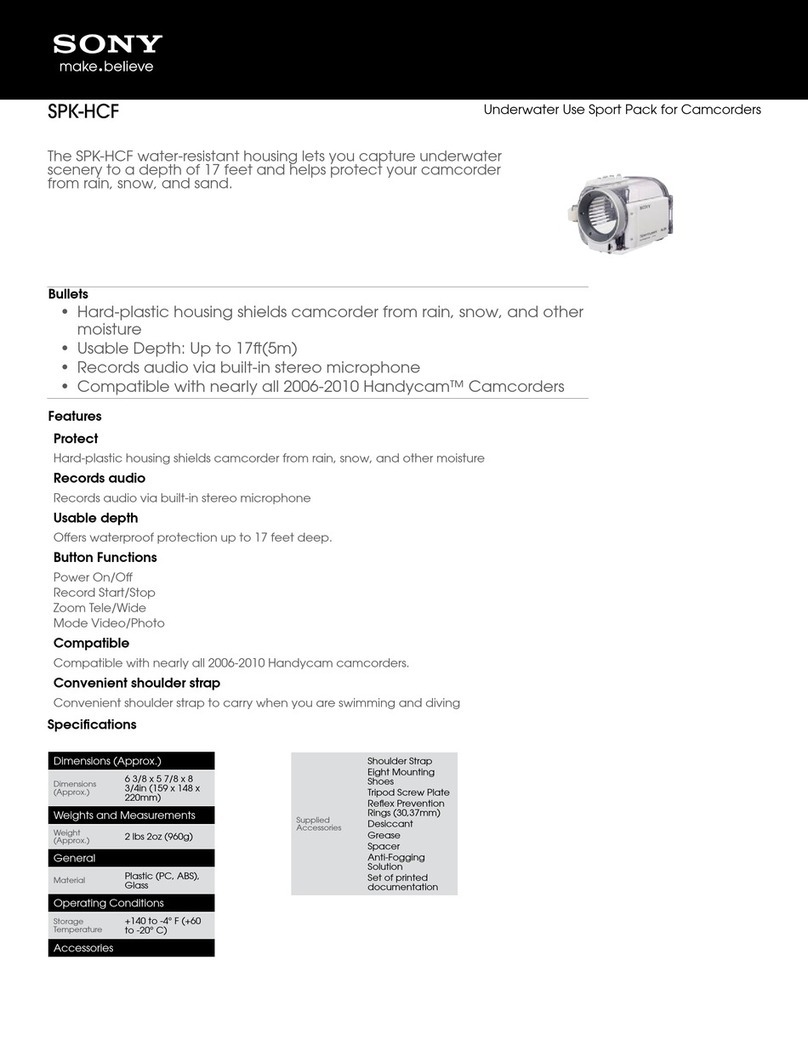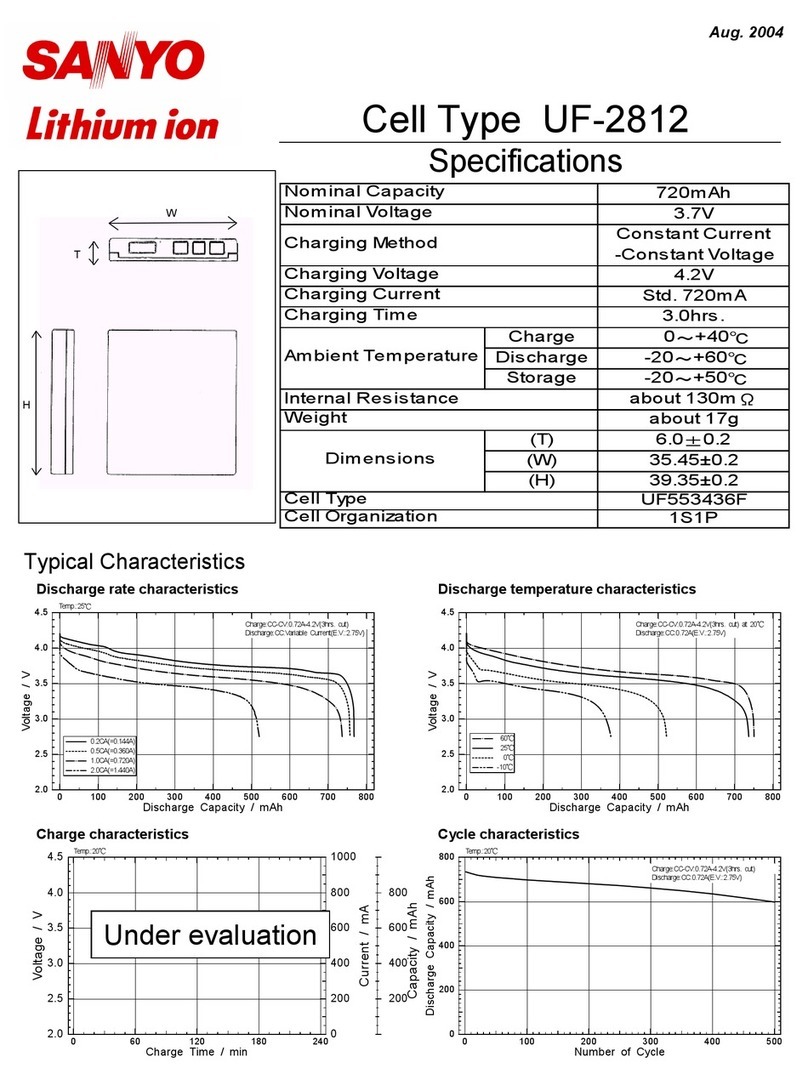Exide EV640 User manual

User guide for
Exide Marine &
Leisure Equipment
Lithium-ion
batteries
EXIDE TECHNOLOGIES SAS
5 ALLÉE DES PIERRES MAYETTES
92636 GENNEVILLIERS
FRANCE
TEL: +33 1 41 21 23 00
FAX +33 1 41 21 27 15
EN

5
2
5
index
●English
Warning and general conditions
1. Safety
2. Model range and specications
3. BMS – Battery Management System
4. Battery installation / connection
5. Wireless communication
6. Instructions for safe handling
-
● Italiano
Avvertenze e condizioni generali di utilizzo
1. Sicurezza
2. Gamma prodotti e speciche
3. BMS – Battery Management System
4. Installazione e collegamento della batteria
5. Comunicazione Wireless
6. Istruzioni per l’uso sicuro
● Deutsch
Warnungen und allgemeine Bedingungen
1. Sicherheit
2. Modellpalette und Spezikationen
3. BMS – Batteriemanagement-System
4. Einbau/Anschluss der Batterie
5. Drahtlose Kommunikation
6. Hinweise zur sicheren Handhabung
● Français
Avertissements et Conditions générales
1. Sécurité
2. Gamme de modèles et spécications
3. BMS – (Battery Management System) Circuit de gestion de batterie
4. Installation / connexion batterie
5. Communication sans l
6. Instructions pour une manipulation en toute sécurité
● Español
Advertencias y condiciones generales
1. Seguridad
2. Gama de modelos y especicaciones
3. BMS – Sistema de gestión de baterías
4. Instalación / conexión de la batería
5. Comunicación inalámbrica
6. Instrucciones para un manejo seguro
pag. 1
pag. 3
pag. 4
pag. 5
pag. 7
pag. 7
pag. 8
pag. 8
pag. 9
pag. 10
pag. 11
pag. 12
pag. 14
pag. 14
pag. 15
pag. 15
pag. 16
pag. 17
pag. 18
pag. 19
pag. 21
pag. 21
pag. 22
pag. 22
pag. 23
pag. 24
pag. 25
pag. 26
pag. 28
pag. 28
pag. 29
pag. 29
pag. 30
pag. 31
pag. 32
pag. 33
pag. 35
pag. 35
pag. 36
pag. 36

5
3
Warning and general conditions
These instructions contain basic information and guidance to be noted and followed during operation and maintenance and
must be read by all users.
● Observe these Instructions and keep them located near the battery for future reference
● Work on the battery should only be carried out by qualied personnel
● Do not dispose of the batteries in a re
● Do not smoke
● While working on batteries, wear protective eye-glasses and clothing
● Explosion and re hazard. Avoid short circuits
● Avoid electrostatic charges and discharges/sparks
● Caution – parts of the battery may dissipate high currents. Be careful when connecting and handling cables
● Lithium-ion batteries are heavy. Make sure they are installed securely
● Handle with care, the batteries are sensitive to mechanical shock
● Do not lift or pull up on the poles
● Do not wear any metallic items such as watches, bracelets, et cetera
● Never try to open the battery. The electrolyte is very corrosive. During normal operation, contact with the electrolyte cannot happen
● If the battery housing is damaged, any direct contact with the exposed electrolyte or powder might result in injury, as the material is corrosive
● To be prepared for an emergency case the Instruction for Safe Handling of Lithium Batteries shall be read and understood
● Use certied insulated safety tools for installation. Any work procedures and tools used should be in compliance to EN 60900 or similar standard
● Charging the Li-ion battery after it has been discharged below the cut-o voltage or if the Li-ion battery is damaged
or taking it over the nominal charge then the Li-ion battery can release a harmful mixture of gasses
● Keep children away from batteries
● Battery may require recycling in accordance with local legislation
● Contact dealer or regulatory authorities for further information
● Spent Li-ion batteries MUST be returned to Li-ion battery collection points
● DO NOT dispose of the battery in normal waste
● DO NOT return Li-ion batteries together with Lead Acid batteries
● Keep the battery dry
● Pressure washing not allowed

5
4
1. Safety
1.1 General recommendation
Each person given the task of operating or maintaining the battery must have read and understood the instructions. Only qualied
personnel should install the batteries. Knowledge of the contents of the installation and user manual is a fundamental requirement
to protect people from danger, to avoid errors and to operate the system safely and fault-free.
1.2 Installation / Operation
● For the rst use, before connecting the battery packs to your equipment fully charge the battery (see section 2)
● The operating conditions given in the product documentation must be observed
● The battery contains a BMS with integrated protection and with the capability to disconnect all battery power resulting in 0 V and 0 A
● A battery which gets disconnected by BMS during use can lead to immediate loss of function for connected equipment.
Do not install or use in systems where sudden loss of battery power may lead to dangerous situations or result in malfunction or
damage of connected equipment
● The battery is intended for equipment use only. Do not use for starting power (engine crank) or other similar applications
● If the battery is damaged, deformed, abnormally hot or emits an odor, please cut o the power immediately and stop using it and
contact your local dealer
1.3 Battery Maintenance
● Exide Li-ion charger is recommended to be used. If using any other charger it must respect the charging requirements of the
battery (see section 2)
● Depending on battery type, if the battery voltage is lower than 10 V / 20 V / 30 V the BMS will disconnect (over discharge protection)
and enter sleep mode to protect the battery from further discharge. Apply charging voltage to wake up BMS and recharge battery
immediately
● The user should verify the condition of all external cables and connections prior to each operation
● Before carrying out any inspection of cables the battery must be disconnected from the application and the charger
1.4 Storage conditions
● Disconnect all loads from the battery before storage
● In case of long term storage (>6 months), battery must be kept dry and frost free. Storage temperature 15 – 35 °C, recommended
storage humidity 5 ~ 75%
● In case of long term storage (>6 months), maintain battery state of charge (SOC) close to 50% by maintenance charge every
6 months
● For seasonal storage (up to 6 months) charge the battery to above 50% SOC before disconnecting.
Suggested storage temperatures up to 1 month -20°C ~ 50℃, up to 3 months -10°C ~ 45°C
● Before taking the battery into use after storage, fully charge the battery
5

2. Model range and specications
Model Nominal
Voltage Rated
Capacity Rated
Energy (Wh) BT Heater Serial Parallel Box
size Dimension
L*W*H (mm) Weight
(Kg)
EV640 12.8 V 50 Ah 640 Y Yes 2 4 D31 307 x 170 x 216 8.5
EV1250 12.8 V 96 Ah 1250 Y Yes 2 4 L05 350 x 176 x 188 10.7
EV1300 12.8 V 100 Ah 1300 Y Yes 2 4 D31 307 x 170 x 216 11.7
EV1600 12.8 V 125 Ah 1600 N No 2 4 27F 318 x 165 x 215 15.0
EV2500 12.8 V 200 Ah 2500 Y Yes 2 4 F51 485 x 170 x 245 25.0
EV1300/24 25.6 V 50 Ah 1300 Y Yes No 4 G77 307 x 170 x 215 12.3
EV3800/36 38.4 V 100 Ah 3800 Y No No 4 H52 520 x 269 x 221 39.0
5
2.1 Model range and specications
2.2 Heater specication
The batteries equipped with a heater can be charged from -20°C to 45°C. When charging at temperatures below 0 °C (down to
-20 °C) power from the charger will be used by the integrated heater to warm up the battery (~1°C / 3 min). When the internal
battery temperature reaches ~0 °C the battery will commence automatically to charge the battery.
2.3 Discharge recommendations
Do not exceed below current levels for discharging the battery. If fully discharged (0 % SOC or low voltage disconnect by BMS)
recharge without delay. Never leave the battery in a fully discharged state.
Model Nominal
Voltage Rated
Capacity Temperature range Constant
Discharge Current Peak Discharge(current / duration)
EV640 12.8 V 50 Ah -20°C / 60°C 50 A 170 A +/- 10 A 2s +/- 1
EV1250 12.8 V 96 Ah -20°C / 60°C 100 A 400 A +/- 20 A 5s +/- 1
EV1300 12.8 V 100 Ah -20°C / 60°C 100 A 300 A +/- 20 A 3.5s +/- 1
EV1600 12.8 V 125 Ah -20°C / 60°C 100 A 350 A +/- 20 A 3s +/- 1
EV2500 12.8 V 200 Ah -20°C / 60°C 160 A 400 A +/- 20 A 3.5s +/- 1
EV1300/24 25.6 V 50 Ah -20°C / 60°C 50 A 80 A +/- 5 A 2s +/- 1
EV3800/36 38.4 V 100 Ah -20°C / 60°C 50 A 350 A +/- 30 A 2s +/- 1
Currents higher than maximum allowed MUST BE AVOIDED since may shorten battery life or lead to premature failure, and may damage the
connected equipment if BMS protection occurs
2.4 Charge recommendations
For maximum long term performance and endurance of the battery the standard charge method should be used. Never charge the
battery with voltages or currents above the MAX levels as listed in the tables below. For optimal charge process and to facilitate
correct function of the charger all loads should be removed during charge.
5
2.4.1 Standard charge
Model Nominal
Voltage Rated
Capacity Temperature
range Charge current
(0.3 C) Charge voltage Cut-o current
(0.05 C)*
EV640 12.8 V 50 Ah -20°C / 45°C 15 A 14.6 V 2.5 A
EV1250 12.8 V 96 Ah -20°C / 45°C 30 A 14.6 V 5 A
EV1300 12.8 V 100 Ah -20°C / 45°C 30 A 14.6 V 5 A
EV1600 12.8 V 125 Ah 0°C / 45°C 40 A 14.6 V 6 A
EV2500 12.8 V 200 Ah -20°C / 45°C 60 A 14.6 V 10 A
EV1300/24 25.6 V 50 Ah -20°C / 45°C 15 A 29.2 V 2.5 A
EV3800/36 38.4 V 100 Ah 0°C / 45°C 30 A 43.8 V 5 A
The standard charge method is CC-CV using the current and voltage levels as listed below.
*The charging should be ended or continue with oat charge voltage when cut-o is reached. It is not recommended to maintain the voltage above
oat charge level when the battery is fully charged
Note: Batteries without heater MUST NOT be charged below 0 °C.

5
2.4.2 Charging voltage ranges
6
Model Nominal
Voltage Rated
Capacity Temperature
range MAX charge
voltage* Charge voltage
range** Float charge voltage
(±0.2 V)
EV640 12.8 V 50 Ah -20°C / 45°C 14.6 V 13.6 – 14.6 V 13.8 V
EV1250 12.8 V 96 Ah -20°C / 45°C 14.6 V 13.6 – 14.6 V 13.8 V
EV1300 12.8 V 100 Ah -20°C / 45°C 14.6 V 13.6 – 14.6 V 13.8 V
EV1600 12.8 V 125 Ah 0°C / 45°C 14.6 V 13.6 – 14.6 V 13.8 V
EV2500 12.8 V 200 Ah -20°C / 45°C 14.6 V 13.6 – 14.6 V 13.8 V
EV1300/24 25.6 V 50 Ah -20°C / 45°C 29.2 V 27.4 – 29.2 V 27.6 V
EV3800/36 38.4 V 100 Ah 0°C / 45°C 43.8 V 41.2 – 43.8 V 41.4 V
*Voltages higher than maximum allowed MUST BE AVOIDED since they may shorten battery life or lead to premature failure, and may damage the
connected equipment if BMS protection is triggered
**The higher end of the range is recommended to ensure full utilization of the battery capacity
2.4.3 Charging current ranges
Model Nominal
Voltage Rated
Capacity Temperature
range Standard charge
current* (0.3 C) Fast charge
current** (0.5C) Max charge cur-
rent***
EV640 12.8 V 50 Ah -20°C / 45°C 15 A 25 A 50 A
EV1250 12.8 V 96 Ah -20°C / 45°C 30 A 48 A 80 A
EV1300 12.8 V 100 Ah -20°C / 45°C 30 A 50 A 100 A
EV1600 12.8 V 125 Ah 0°C / 45°C 40 A 80 A 125 A
EV2500 12.8 V 200 Ah -20°C / 45°C 60 A 100 A 160 A
EV1300/24 25.6 V 50 Ah -20°C / 45°C 15 A 25 A 50 A
EV3800/36 38.4 V 100 Ah 0°C / 45°C 30 A 50 A 50 A
C-rate, current (A) as a factor of rated capacity (Ah).
* Recommended current (A) to ensure maximum lifespan
** Recommended current (A) for occasional fast recharge
*** Maximum allowed current (A) (not recommended)
Currents higher than maximum allowed MUST BE AVOIDED. since it may shorten battery life or lead to premature failure, and may damage the
connected equipment if BMS protection is triggered.
5

3. BMS – Battery Management System
5
7
The battery is equipped with an advanced integrated electronic Battery Management System, BMS. The BMS monitors the state
of the battery by measuring voltages, temperatures and the electrical current in and out of the battery. The BMS performs balan-
cing of the battery cells inside the battery and operates the heater (for applicable products). Battery models with Bluetooth allow
the user to receive information of the battery status from the BMS.
3.1 BMS integrated protection
To protect or minimize damage to the battery from abuse situations there are built-in protection limits for voltage, temperature and
current. Systematic or intentional triggering of the BMS protection must be avoided and may cause permanent damage to the
battery.
WARNING! If the battery is used outside the permitted ranges the BMS will enter protection mode and trigger an electronic dis-
connect of the battery. Disconnection by the BMS results in sudden loss of battery power and may lead to total loss of function
for connected equipment.
3.1.1 BMS protection levels
For correct operation refer to recommendations and ranges (voltage, current and temperature) for charge and discharge in section
2.
BMS protection modes
BMS protection modes are listed below including trigger, release and possible or required action to restore battery to normal state.
Triggered protection will be communicated via Bluetooth for batteries with this function.
Protection mode Trigger Release Action to restore
Over charge / Over voltage
Any cell >3.75 V
Battery* >15.0 V (12 V)
Battery* >30.0/45.0 V (24/36 V)
Cell(s) <3.60 V
Battery* <14.4 V (12 V)
Battery* <28.8/43.2 V (24/36 V)
Allow to rest or apply
discharge to battery
Over discharge /
Under voltage**
Any cell < 2.50 V
Battery* <10.0 (12 V)
Battery* <20.0/30.0 V (24/36 V)
Cell(s) >2.80 V
Battery* >11.2 V (12 V)
Battery* >22.4/33.6 V (24/36 V) Apply charge to battery.
Over current charging Exceeding charging current
ranges, see levels for specic
battery model in section 2.4
Automatic release,
time-out up to 1 minute.
Allow to rest or apply
discharge to battery
Over current discharging Exceeding discharging current
ranges, see levels for specic
battery model in section 2.3
Automatic release,
time-out up to 1 minute.
Allow to rest or apply charge
to battery
Over temperature
Temperature above allowed
range, see levels for specic
battery model in section 2.3
and 2.4
Temperature within range
(~5 °C margin) Allow battery to cool down
Under temperature***
Temperature below allowed
range, see levels for specic
battery model in section 2.3
and 2.4
Temperature within range
(~5 °C margin) Allow battery to heat up. Apply
charge to activate heater
4.1 Battery orientation
Install the battery in an upright position only. Never upside down or on the sides. Incorrect orientation may lead to premature failure or pose a
safety risk.
4. Battery installation / connection
X
X
*Battery voltages are indicative only. Protection is triggered and released by cell voltages
**Note that Bluetooth connection will be disabled while over discharge protection trigger is active
***Batteries with heater will prohibit charge if temperature is too low (<0°C) and utilize charging current to heat up the battery. Charging of the
battery will commence automatically once battery is suciently heated

5
8
4.2 Battery Installation
● Do not install the battery in a place where it is exposed to direct sunlight or sources of heat (e.g. engine compartments, engine
exhaust systems, electrical/hydraulic pumps or any other device which generates heat under normal or exceptional operating
conditions)
● Keep any ammable material away from the battery and its connected loads or chargers
● Do not install in compartments with zero clearance, always leave space around the battery for ventilation and cooling
● Li-ion batteries must always be kept in a well ventilated, dry, clean and dust-free environment
● Never expose the battery to re or extreme heat
● Keep the battery dry and clean from dirt
● Battery surface should be cleaned with a soft, dry cloth made of non-electro conductive material
● Under no circumstances should liquids, cleaning agents or solvents be used to clean a battery
4.3 Precautions for battery serial connection
● Check table 2.1 if serial connection is possible for a specic battery model
● Maximum number of batteries that can be connected in series is listed in table 2.1
● The batteries connected in series must be of the same model, voltage and preferably from the same batch
● Before connecting batteries in series all batteries must be fully charged
4.4 Precautions for battery parallel connection
● Check table 2.1 if parallel connection is possible for a specic battery model
● Maximum number of batteries in parallel is listed in table 2.1
● The batteries connected in parallel should be of the same model, voltage and preferably from the same batch
● Ensure that all parallel wires are identical (length, section and insulation)
● Before connecting batteries in parallel all batteries must be fully charged
The batteries equipped with Bluetooth can be monitored with a mobile phone using the Exide Application. Features that can be
monitored in the app include: battery voltage, current, state of charge, temperature, cycle count and alarms.The Exide Mobile
Application can be downloaded from App Store (iOS) and Google Play (Android).
5. Wireless communication
6. Instructions for safe handling
6.1 Leaking Batteries
● If a battery leaks electrolyte, avoid contact with the leaking liquid or gas. If exposed to the leaking substance, immediately
perform the actions described below:
● Inhalation: Evacuate the contaminated area, and seek medical attention
● Contact with eyes: Rinse eyes with owing water for 15 minutes, and seek medical attention
● Contact with skin: Wash the aected area thoroughly with soap and water, and seek medical attention
● Ingestion: Induce vomiting, and seek medical attention
6.2 Fire
● Use CO2, Dry Powder or Foam extinguisher if available
● Use copious amounts of water or sand to cover the battery if available
● If possible and safe to do so, move the battery pack to a safe area
6.3 Damaged Batteries
Damaged batteries may be dangerous and must be handled carefully. If a battery is damaged do not use it and contact your local
dealer.
6.4 Transportation
During transportation, the battery should be handled with care and should not be subjected to severe impact. During transporta-
tion, severe bumps and shaking should be avoided, and moisture, rain and long-term exposure to the sun should be avoided.

Guida all’utilizzo
delle batterie
Exide Marine &
Leisure Equipment
Lithium-ion
EXIDE TECHNOLOGIES SAS
5 ALLÉE DES PIERRES MAYETTES
92636 GENNEVILLIERS
FRANCE
TEL: +33 1 41 21 23 00
FAX +33 1 41 21 27 15
IT

5
10
Avvertenze e condizioni generali di utilizzo
Le seguenti istruzioni contengono informazioni essenziali e line guida che devono essere lette e scrupolosamente seguite
durante l’utilizzo e la manutenzione da parte di ogni utilizzatore.
● Leggere attentamente le istruzioni e tenerle sempre a portata di mano
● Ogni operazione sulle batterie dove essere eseguita da personale qualicato
● Evitare il contatto con amme libere o fonti di calore
● Non fumare
● Quando si lavora sulle batterie indossare sempre occhiali a abbigliamento protettivi
● Attenzione: rischio di esplosione e incendio. Evitare i corto circuiti
● Attenzione: evitare cariche elettrostatiche e scintille
● Attenzione: parti della batteria possono erogare correnti elevate. Prestare attenzione durante le operazioni di collegamento dei cavi
● Le batterie li-ion sono pesanti. Assicurarsi che siano installate in modo stabile e sicuro
● Maneggiare con cura, le batterie sono sensibili agli urti
● Non sollevare le batterie dai terminali
● Non indossare oggetti metallici come orologi, braccialetti e simili
● Non cercare di aprire la batteria. L’elettrolita è molto corrosivo. Durante il normale utilizzo l’elettrolita non può fuoriuscire
● In caso l’involucro della batteria sia danneggiato, il contatto diretto con l’elettrolita o tracce dello stesso contenute all’interno può
provocare ustioni, essendo l’elettrolita corrosivo
● Al ne di fronteggiare adeguatamente una eventuale emergenza leggere attentamente le istruzioni d’uso
● Utilizzare strumenti provvisti di isolamento elettrico certicati. Ogni operazione sulla batteria deve essere condotta in conformità alle
prescrizioni della norma EN 60900 o similare
● La ricarica di batterie che sono state scaricate al di sotto dei limiti (cut-o) previsti, o di batterie danneggiate, e la ricarica con correnti
al di sopra dei limiti raccomandati possono comportare il rilascio di gas tossici
● Tenere lontano dalla portata dei bambini
● Riciclare la batterie secondo le disposizioni vigenti
● Contattare il rivenditore o le autorità competenti per maggiori informazioni
● Le batterie esauste DEVONO essere smaltite presso punti di raccolta specici per le batterie li-ion
● NON gettare le batterie li-ion insieme ai normali riuti
● NON smaltire le batterie Li-Ion insieme a quelle Piombo-Acido
● Mantenere all’asciutto
● Non utilizzare getti d’acqua per il lavaggio
5

● Le batterie li-ion sono pesanti. Assicurarsi che siano installate in modo stabile e sicuro
● Maneggiare con cura, le batterie sono sensibili agli urti
● Non sollevare le batterie dai terminali
● Non indossare oggetti metallici come orologi, braccialetti e simili
● Non cercare di aprire la batteria. L’elettrolita è molto corrosivo. Durante il normale utilizzo l’elettrolita non può fuoriuscire
● In caso l’involucro della batteria sia danneggiato, il contatto diretto con l’elettrolita o tracce dello stesso contenute all’interno può
provocare ustioni, essendo l’elettrolita corrosivo
● Al ne di fronteggiare adeguatamente una eventuale emergenza leggere attentamente le istruzioni d’uso
● Utilizzare strumenti provvisti di isolamento elettrico certicati. Ogni operazione sulla batteria deve essere condotta in conformità alle
prescrizioni della norma EN 60900 o similare
● La ricarica di batterie che sono state scaricate al di sotto dei limiti (cut-o) previsti, o di batterie danneggiate, e la ricarica con correnti
al di sopra dei limiti raccomandati possono comportare il rilascio di gas tossici
5
11
1. Sicurezza
1.1 Raccomandazioni generali
Ogni persona che operi sulla batteria deve prendere visione delle seguenti istruzioni. La batteria deve essere installata solo da
personale qualicato. La conoscenza e comprensione del contenuto del presente manuale è un requisito fondamentale per la
sicurezza e la protezione delle persone, e per assicurare il corretto funzionamento dei sistemi o impianti ad essa collegati.
1.2 Installazione / messa in servizio
● Prima dell’utilizzo/collegamento della batteria, eettuare una ricarica completa (vedere la sezione 2)
● Rispettare le condizioni di utilizzo indicate nel presente manuale
● La batteria ha un BMS (Battery Management System) con funzioni di protezione e la capacità di scollegare completamente
la batteria (0 V e 0 A)
● Se la batteria viene disconnessa dal BMS durante l’uso, questo comporta l’immediata perdita di funzionalità di ogni utenza ad essa
collegata. Non installare o usare la batteria su impianti dove tale immediate perdita di funzionalità può comportare pericolo o rischio di
danno o malfunzionamento ai componenti ad essa collegati
● La batteria è progettata per uso stazionario. Non utilizzare per avviamento motore o simili applicazioni
● In caso la batteria risulti danneggiata, rovinata, particolarmente calda o emetta odori, scollegarla immediatamente, interrompere ogni
utilizzo, e contattare il rivenditore
1.3 Manutenzione
● Si raccomanda l’uso del caricabatteria Exide specico per li-ion. Se un tipo diverso di caricabatteria viene utilizzato,
assicurarsi che rispetti i parametri di ricarica indicati nella sezione 2
● A seconda del modello di batteria (se 12, 24 o 36V), se la tensione cala al di sotto di 10V / 20V / 30V, il BMS scollega la stessa
(protezione da sotto-scarica) e entra in “sleep-mode” per proteggere la batteria da ulteriore scarica. Applicare una tensione di
ricarica alla batteria per riattivare il BMS e ricaricarla immediatamente
● Si raccomanda di vericare la condizione di ogni cavo e collegamento prima di eettuare ogni operazione
● Prima di ispezionare i cavi o i collegamenti della batteria assicurarsi di scollegarla dal caricabatteria e dalle utenze collegate
1.4 Conservazione
● Scollegare ogni utenza dalla batteria
● Se la batteria è inutilizzata per lunghi periodi (>6 mesi), deve essere conservata in luogo asciutto e al riparo dal gelo. Temperatura
raccomandata 15 – 35°, umidità raccomandata 5 - 75%
● Se la batteria è inutilizzata per lunghi periodi (>6 mesi), mantenere il suo stato di carica (SoC) al 50% circa, eettuando
ricariche di mantenimento ogni 6 mesi
● Per lo stoccaggio stagionale (no a 6 mesi), ricaricare la batteria al di sopra del 50 % SoC (stato di carica) prima di metterla a
riposo. Per periodi di stoccaggio non superiori ad 1 mese, si raccomanda di mantenere la batteria tra -20°C e 50°C, se non superiori
a 3 mesi tra 10°C e 45°C
● Prima di utilizzare la batteria dopo lo stoccaggio, eettuare una ricarica completa

2. Gamma prodotti e speciche
Modello Tensione
nominale Capacità
nominale
Energia
nominale
(Wh)
Blue
tooth Riscal-
datore
Connes-
sione in
serie
Connes-
sione in
parallelo Tipo box Dimensioni
L x W x H (mm) Peso
(Kg)
EV640 12.8 V 50 Ah 640 Y Yes 2 4 D31 307 x 170 x 216 8.5
EV1250 12.8 V 96 Ah 1250 Y Yes 2 4 L05 350 x 176 x 188 10.7
EV1300 12.8 V 100 Ah 1300 Y Yes 2 4 D31 307 x 170 x 216 11.7
EV1600 12.8 V 125 Ah 1600 N No 2 4 27F 318 x 165 x 215 15.0
EV2500 12.8 V 200 Ah 2500 Y Yes 2 4 F51 485 x 170 x 245 25.0
EV1300/24 25.6 V 50 Ah 1300 Y Yes No 4 G77 307 x 170 x 215 12.3
EV3800/36 38.4 V 100 Ah 3800 Y No No 4 H52 520 x 269 x 221 39.0
5
2.1 Panoramica dei prodotti
2.2 Caratteristiche del riscaldatore
Le batterie equipaggiate con riscaldatore possono essere ricaricate tra -20°C e 45°C. Se ricaricate a temperature negative (no a
-20°C) la corrente del carica batteria viene utilizzata dal riscaldatore per riscaldare la batteria (circa 1°C / 3 min). Quando la tempe-
ratura interna della batteria raggiunge ~0°C il carica batterie inizia automaticamente a ricaricare la batteria.
2.3 Indicazioni di scarica
Non eccedere i limiti indicati di seguito. Se la batteria raggiunge la complete scarica (0 % SoC o disconnessione da parte del
BMS) ricaricare la batteria immediatamente. Non lasciare mai la batteria completamente scarica.
Modello Tensione
nominale Capacità
nominale Temperature
ammesse Corrente di
scarica continua Corrente di scarica
(corrente / durata) di picco
EV640 12.8 V 50 Ah -20°C / 60°C 50 A 170 A +/- 10 A 2s +/- 1
EV1250 12.8 V 96 Ah -20°C / 60°C 100 A 400 A +/- 20 A 5s +/- 1
EV1300 12.8 V 100 Ah -20°C / 60°C 100 A 300 A +/- 20 A 3.5s +/- 1
EV1600 12.8 V 125 Ah -20°C / 60°C 100 A 350 A +/- 20 A 3s +/- 1
EV2500 12.8 V 200 Ah -20°C / 60°C 160 A 400 A +/- 20 A 3.5s +/- 1
EV1300/24 25.6 V 50 Ah -20°C / 60°C 50 A 80 A +/- 5 A 2s +/- 1
EV3800/36 38.4 V 100 Ah -20°C / 60°C 50 A 350 A +/- 30 A 2s +/- 1
Correnti di scarica maggiori di quanto indicato DEVONO ESSERE EVITATE perché potrebbero ridurre la vita della batteria o provocare un danno
permanente alla stessa, e possono inoltre danneggiare le utenze collegate se il BMS disconnette la batteria.
2.4 Indicazioni di ricarica
Per una ricarica ottimale e per garantire un corretto funzionamento del carica batteria si raccomanda di scollegare tutte le utenze.
12
2.4.1 Ricarica standard
Modello Tensione
nominale Capacità
nominale Temperature
ammesse Corrente di
carica (0.3 C) Tensione di
carica Corrente di Cut-o
(0.05 C)*
EV640 12.8 V 50 Ah -20°C / 45°C 15 A 14.6 V 2.5 A
EV1250 12.8 V 96 Ah -20°C / 45°C 30 A 14.6 V 5 A
EV1300 12.8 V 100 Ah -20°C / 45°C 30 A 14.6 V 5 A
EV1600 12.8 V 125 Ah 0°C / 45°C 40 A 14.6 V 6 A
EV2500 12.8 V 200 Ah -20°C / 45°C 60 A 14.6 V 10 A
EV1300/24 25.6 V 50 Ah -20°C / 45°C 15 A 29.2 V 2.5 A
EV3800/36 38.4 V 100 Ah 0°C / 45°C 30 A 43.8 V 5 A
Il metodo di ricarica standard è CC-CV (corrente costante – tensione costante) utilizzando le tensioni indicate di seguito.
*La ricarica dovrebbe terminare, o continuare come ricarica di mantenimento (oat-charge), quando la tensione di cut-o viene raggiunta.
Si raccomanda di non mantenere la tensione di ricarica quando la batteria raggiunge la carica completa
Nota: Le batterie prive di riscaldatore NON devono essere ricaricate a temperature inferiori a 0° C
5

5
2.4.2 Gamma delle tensioni di ricarica
13
Modello Tensione
nominale Capacità
nominale Temperature
ammesse Massima tensione
di ricarica* Intervallo tensioni
di ricarica** Tensione ricarica di
mantenimento(±0.2 V)
EV640 12.8 V 50 Ah -20°C / 45°C 14.6 V 13.6 – 14.6 V 13.8 V
EV1250 12.8 V 96 Ah -20°C / 45°C 14.6 V 13.6 – 14.6 V 13.8 V
EV1300 12.8 V 100 Ah -20°C / 45°C 14.6 V 13.6 – 14.6 V 13.8 V
EV1600 12.8 V 125 Ah 0°C / 45°C 14.6 V 13.6 – 14.6 V 13.8 V
EV2500 12.8 V 200 Ah -20°C / 45°C 14.6 V 13.6 – 14.6 V 13.8 V
EV1300/24 25.6 V 50 Ah -20°C / 45°C 29.2 V 27.4 – 29.2 V 27.6 V
EV3800/36 38.4 V 100 Ah 0°C / 45°C 43.8 V 41.2 – 43.8 V 41.4 V
* Correnti di scarica maggiori di quanto indicato DEVONO ESSERE EVITATE perché potrebbero ridurre la vita della batteria o provocare un danno
permanente alla stessa, e possono inoltre danneggiare le utenze collegate se il BMS disconnette la batteria
**Il limite superiore della gamma di tensioni di ricarica è quello che garantisce l’utilizzo maggiore della capacità della batteria
2.4.3 Gamma delle correnti di ricarica
Modello Tensione
nominale Capacità
nominale Temperature
ammesse Corrente di ricarica
standard* (0.3 C) Corrente di ricari-
ca rapida** (0.5C) Massima corrente di
ricarica***
EV640 12.8 V 50 Ah -20°C / 45°C 15 A 25 A 50 A
EV1250 12.8 V 96 Ah -20°C / 45°C 30 A 48 A 80 A
EV1300 12.8 V 100 Ah -20°C / 45°C 30 A 50 A 100 A
EV1600 12.8 V 125 Ah 0°C / 45°C 40 A 80 A 125 A
EV2500 12.8 V 200 Ah -20°C / 45°C 60 A 100 A 160 A
EV1300/24 25.6 V 50 Ah -20°C / 45°C 15 A 25 A 50 A
EV3800/36 38.4 V 100 Ah 0°C / 45°C 30 A 50 A 50 A
C-rate, corrente (A) come fattore della capacità nominale (Ah)
* Corrente (A) raccomandata per la massima durata di vita
** Corrente (A) raccomandata per ricarica rapida occasionale
*** Corrente (A) massima ammessa (non raccomandata)
Correnti di ricarica maggiori di quanto indicato DEVONO ESSERE EVITATE perché potrebbero ridurre la vita della batteria o provocare un danno
permanente alla stessa, e possono inoltre danneggiare le utenze collegate se il BMS disconnette la batteria.

3. BMS – Battery Management System
5
14
La batteria è equipaggiata con un Battery Management System (BMS) elettronico integrato. Il BMS monitora lo stato della batteria
misurando tensioni, temperature e correnti in ingresso e uscita. Il BMS assicura inoltre il bilanciamento tra le celle della batteria
and gestisce il riscaldatore (dove presente). Le batterie equipaggiate di modulo Bluetooth consentono all’utente di ricevere infor-
mazioni sullo stato della batteria dal BMS stesso.
3.1 BMS tipo di protezione
Per ridurre al minimo il rischio di danno alla batteria conseguente ad un suo abuso, sono stati impostati dei limiti di protezione per
tensione, temperatura e corrente. Il raggiungimento sistematico o intenzionale di tali limiti dove essere evitato dal momento che
questa situazione può arrecare danno alla batteria.
ATTENZIONE! Se la batteria viene utilizzata al di fuori dei limiti previsti, il BMS entra in modalità protezione ed eettua la dis-
connessione della batteria. Tale disconnessione comporta la immediata perdita di funzionalità della batteria e può danneggiare le
utenze ad essa collegate.
3.1.1 BMS livelli di protezione
Per un utilizzo corretto fare riferimento alle indicazioni e limiti (tensione, corrente e temperatura) per la scarica e la ricarica indicati
nella sezione 2.
BMS modalità di protezione
I livelli indicati di seguito comprendono soglie di attivazione e disattivazione e le azioni richieste o possibili all’utente per ripristi-
nare il normale funzionamento della batteria. Il raggiungimento delle soglie viene comunicato dal Bluetooth per le batterie che ne
sono dotate.
Protezione Soglia attivazione Soglia disattivazione Sblocco
Sovraccarica / sovratensione
Ogni cella >3.75 V
Batteria* >15.0 V (12 V)
Batteria* >30.0/45.0 V (24/36 V)
Ogni cella <3.60 V
Batteria* <14.4 V (12 V)
Batteria* <28.8/43.2 V (24/36 V)
Attendere o scaricare parzial-
mente la batteria
Sottoscarica / Sotto tensione**
Ogni cella < 2.50 V
Batteria* <10.0 (12 V)
Batteria* <20.0/30.0 V (24/36 V)
Ogni cella >2.80 V
Batteria* >11.2 V (12 V)
Batteria* >22.4/33.6 V (24/36 V)
Ricaricare la batteria
Sovra corrente di carica
Superamento dei limiti di ca-
rica indicate nella sezione 2.4
per ogni modello
Automatica dopo 1 minuto Attendere o scaricare
parzialmente la batteria
Sovra corrente di scarica
Superamento dei limiti di sca-
rica indicate nella sezione 2.3
per ogni modello
Automatica dopo 1 minuto Attendere o ricaricare la
batteria
Alta temperature
Temperatura al di sopra dei
limiti indicati nella sezione 2.3
e 2.4 per ogni modello
Temperatura al di sotto dei
limiti indicati (~5 °C tolleranza) Far rareddare la batteria
Bassa temperatura***
Temperatura al di sotto dei
limiti indicate nella sezione 2.3
e 2.4 per ogni modello
Temperatura al di sopra dei
limiti indicati (~5 °C tolleranza)
Far riscaldare la batteria.
Ricaricare la batteria per
attivare il riscaldatore
4.1 Posizioni di montaggio permesse
Installare la batteria solamente in verticale. Mai installare la batteria sottosopra o appoggiata sui lati. La mancata osservanza di queste prescrizioni
possono comportare un danno permanente alla batteria o presentare rischi per la sicurezza.
4. Installazione e collegamento della batteria
X
X5
*Le tensioni sono puramente indicative. La protezione si attiva in base alla tensione di ogni cella
**Nota: la connessione Bluetooth è inattiva quando la protezione da sotto scarica è attiva
***Le batterie dotate di riscaldatore non permettono la ricarica con temperature al di sotto di 0°C e utilizzano la corrente in ingresso dal caricabat-
teria per il riscaldamento della batteria. La ricarica inizia quando la temperatura della batteria raggiunge la soglia indicata

5
15
4.2 Installazione
● Non installare la batteria in luoghi dove risulta esposta alla luce solare diretta o a fonti di calore (ad es. vano motore, tubi di
scarico gas, pompe elettriche/idrauliche o ogni altro componente che genera calore durante il normale funzionamento o in casi
particolari)
● Tenere la batteria e ogni utenza ad essa collegata lontano da ogni materiale inammabile
● Non installare in compartimenti che non consentono una corretta ventilazione e rareddamento della batteria, lasciare
dello spazio attorno ad essa
● Le batterie li-ion devono sempre essere tenute in luoghi ben ventilati, asciutti, puliti e privi di polvere
● Non esporre mai la batteria al fuoco o a calore intenso
● Mantenere la batteria asciutta e priva di polvere
● La supercie della batteria può essere pulita con un panno soce di tessuto non conduttivo
● In nessuna circostanza liquidi, solventi o sgrassanti devono essere usati per pulire la batteria
4.3 Precauzioni per il collegamento in serie di più batterie
● Vericare nella tabella 2.1 che la connessione in serie sia possibile per il modello specico di batteria
● Il numero massimo di batterie che possono essere collegate in serie è indicato nella tabella 2.1
● Le batterie connesse in serie devono essere dello stesso modello, tensione e preferibilmente dello stesso lotto produttivo
● Prima di essere connesse in serie tutte le batterie devono essere ricaricate completamente
4.4 Precauzioni per il collegamento in parallelo di più batterie
● Vericare nella tabella 2.1 che la connessione in parallelo sia possibile per il modello specico di batteria
● Il numero massimo di batterie che possono essere collegate in parallelo è indicato nella tabella 2.1
● Le batterie connesse in parallelo devono essere dello stesso modello, tensione e preferibilmente dello stesso lotto produttivo
● Assicurarsi che tutti i cavi usati per la connessione siano identici (lunghezza, sezione e tipo di isolamento)
● Prima di essere connesse in serie tutte le batterie devono essere ricaricate
Le batterie dotate di Bluetooth possono essere monitorate con la App Exide per smartphone. i parametri che possono essere
monitorati includono tensione, corrente, stato di carica (SoC), temperature, numero di cicli di scarica/carica e allarmi BMS.
La App Exide può essere scaricata da App Store (iOS) e Google Play (Android).
5. Comunicazione Wireless
6. Istruzioni per l’uso sicuro
6.1 Batterie con perdite
● Nel caso una batteria perda elettrolita, evitare il contatto di liquido o gas. In caso di contatto, seguire immediatamente le
istruzioni di seguito:
● Inalazione: evacuare l’area contaminata e rivolgersi al medico
● Contatto con gli occhi: sciacquare abbondantemente con acqua per 15 minuti e rivolgersi al medico
● Contatto con la pelle: lavare accuratamente l’area colpita con acqua e sapone, e rivolgersi al medico
● Ingestione: indurre il vomito e rivolgersi al medico
6.2 Incendio
● Usare estintori a CO2, polvere o schiuma se disponibili
● Usare abbondante acqua o sabbia per coprire la batteria se possibile
● Se possibile e sicuro, spostare la batteria in un luogo sicuro
6.3 Batterie danneggiate
Le batterie danneggiate possono essere pericolose e devono essere maneggiate con cura. Se una batteria è danneggiata non
utilizzarla e rivolgersi al proprio rivenditore.
6.4 Trasporto
Durante il trasporto, la batteria deve essere maneggiata con cura evitando di esporla ad urti. Durante il trasporto, impatti violenti
devono essere evitati, così come l’esposizione prolungata a umidità, pioggia o luce solare diretta.

5
Benutzerhandbuch
für Exide Marine &
Leisure Lithium-Ionen
Batterien
EXIDE TECHNOLOGIES SAS
5 ALLÉE DES PIERRES MAYETTES
92636 GENNEVILLIERS
FRANCE
TEL: +33 1 41 21 23 00
FAX +33 1 41 21 27 15
DE

5
17
Warnungen und allgemeine Bedingungen
Diese Anweisungen enthalten grundlegende Informationen und Richtlinien, die beachtet und im Betrieb wie auch bei War-
tungsarbeiten eingehalten werden müssen. Sie müssen allen Benutzern bekannt sein.
● Beachten Sie diese Anweisungen und bewahren Sie sie in der Nähe der Batterien auf, damit Sie später jederzeit darauf zurückgreifen können
● Arbeiten an der Batterien dürfen nur durch qualiziertes Personal durchgeführt werden
● Entsorgen Sie die Batterien nicht durch Verbrennen.
● Rauchen Sie nicht
● Tragen Sie beim Arbeiten an Batterien Schutzbrille und Schutzkleidung
● Explosions- und Brandgefahr. Vermeiden Sie Kurzschlüsse
● Vermeiden Sie elektrische Auf- und Entladung und Funken
● Vorsicht – Teile der Batterien können hohe Ströme ableiten. Seien Sie vorsichtig, wenn Sie Kabel anschließen und handhaben
● Lithium-Ionen-Batterien sind schwer. Achten Sie auf eine sichere Montage
● Die Batterien sind stoßempndlich und müssen vorsichtig gehandhabt werden
● Die Batterien dürfen nicht an den Polen angehoben oder gezogen werden
● Tragen Sie keine metallischen Gegenstände wie etwa Uhren, Armbänder usw
● Versuchen Sie auf keinen Fall, die Batterie zu önen. Der Elektrolyt ist stark ätzend. Im normalen Betrieb ist ein Kontakt mit dem
Elektrolyten unmöglich
● Wenn das Gehäuse der Batterien beschädigt wird, kann jeder direkte Kontakt mit dem freien Elektrolyten oder Pulver zu Verletzungen
führen, da das Material ätzend ist
● Um auf einen etwaigen Notfall vorbereitet zu sein, müssen die Anweisungen für den sicheren Umgang mit Lithium-Batterien gelesen
und verstanden worden sein
● Verwenden Sie für die Installation geprüfte und isolierte Sicherheitswerkzeuge. Jegliche Arbeitsverfahren und Werkzeuge sollten
EN 60900 oder einem vergleichbaren Standard entsprechen
● Beim Laden der Lithium-Ionen-Batterien kann, wenn sie unter die Abschaltspannung entladen oder beschädigt oder über die
Nennladung überladen wurde, ein gefährliches Gasgemisch freigesetzt werden.
● Halten Sie Kinder von den Batterien fern.
● Die Wiederverwertung der Batterien kann in den örtlichen Gesetzen geregelt sein
● Erkundigen Sie sich bei Ihrem Händler oder den Behörden nach den genauen Bestimmungen
● Verbrauchte Lithium-Ionen-Batterien MÜSSEN an den Sammelstellen für Lithium-Ionen-Batterien abgegeben werden
● Batterien NICHT im normalen Haushaltsmüll entsorgen
● Lithium-Ionen-Batterien NICHT zusammen mit Blei-Säure-Batterien zurückgeben
● Batterie vor Feuchtigkeit schützen
● Keine Hochdruckreinigung
DE

5
18
1. Sicherheit
1.1 Allgemeine Empfehlungen
Jeder, dem die Bedienung oder Wartung der Batterien übertragen wird, muss die Anweisungen gelesen haben. Der Einbau der
Batterien darf nur von qualizierten Personen vorgenommen werden. Die Kenntnis des Inhalts der Installations- und Bedienung-
sanleitung ist eine fundamentale Voraussetzung, um Menschen vor Gefahren zu schützen, Fehler zu vermeiden und den sicheren
und fehlerfreien Betrieb des Systems zu gewährleisten.
1.2 Installation/Betrieb
● Laden Sie die Batterien vor der ersten Verwendung vollständig auf, bevor Sie sie an Ihre Geräte anschließen (siehe Abschnitt 2)
● Die in der Produktdokumentation angegebenen Betriebsbedingungen müssen eingehalten werden
● Die Batterien enthält ein Batteriemanagement-System (BMS) mit integriertem Schutz und der Fähigkeit, den gesamten
Stromkreis der Batterie zu unterbrechen, was zu 0 V und 0 A führt
● Eine Batterien, die während des Betriebs vom BMS abgeklemmt wird, kann zu einem sofortigen Funktionsverlust der angeschlossenen
Geräte führen. Installieren oder verwenden Sie die Batterie nicht in Systemen, in denen ein plötzlicher Verlust der Batteriespannung
zu gefährlichen Situationen, zu Fehlfunktionen oder Schäden an angeschlossenen Geräten führen kann
● Die Batterien ist nur für die Versorgung von Geräten bestimmt. Verwenden Sie sie nicht zum Starten (Anlassen) eines Motors
oder für andere ähnliche Anwendungen
● Wenn die Batterien beschädigt oder verformt ist, ungewöhnlich heiß wird oder einen Geruch abgibt, trennen Sie sie sofort von
den Verbrauchern, verwenden Sie sie nicht mehr und wenden Sie sich an Ihren Händler vor Ort.
n
1.3 Wartung der Batterien
● Es wird empfohlen, ein Exide Li-Ionen-Ladegerät zu verwenden. Wenn Sie ein anderes Ladegerät verwenden,
muss es die Ladeanforderungen der Batterie erfüllen (siehe Abschnitt 2)
● Je nach Batterietyp schaltet das BMS bei einer Batteriespannung von weniger als 10/20/30 V ab (Tief-/Überentladungsschutz)
und geht in den Ruhezustand über, um die Batterie vor weiterer Entladung zu schützen. Um das BMS wieder zu aktivieren und die
Batterie sofort aufzuladen, legen Sie die Ladespannung an
● Die Bedienperson muss vor jeder Benutzung den Zustand aller externen Kabel und Stecker überprüfen
● Vor der Überprüfung der Kabel muss die Batterien von den Verbrauchern und dem Ladegerät getrennt werden
1.4 Lagerbedingungen
● Klemmen Sie vor der Lagerung alle Verbraucher von der Batterien ab
● Bei langfristiger Lagerung (> 6 Monate) muss die Batterie trocken und frostfrei gelagert werden. Lagertemperatur 15–35 °C,
empfohlene Luftfeuchtigkeit 5 ~ 75 %
● Bei langfristiger Lagerung (> 6 Monate) muss der Ladezustand der Batterien (SOC) durch eine Erhaltungsladung
alle 6 Monate bei etwa 50 % gehalten werden
● Bei saisonaler Lagerung (bis zu 6 Monaten) laden Sie die Batterien vor dem Abklemmen auf über 50 % SOC auf. Empfohlene
Lagertemperaturen bis zu 1 Monat –20 °C ~ 50 °C, bis zu 3 Monate –10 °C ~ 45 °C.
● Bevor Sie die Batterien nach der Lagerung in Betrieb nehmen, laden Sie sie vollständig auf
5

2. Modellpalette und Spezikationen
Modell Nennspan-
nung Nennkapazität Nennenergie
(Wh) BT Heizung Seriell Parallel Gehäuse-
größe
Abmessungen
LxBxH
(mm)
Gewicht
(Kg)
EV640 12.8 V 50 Ah 640 Y Yes 2 4 D31 307 x 170 x 216 8.5
EV1250 12.8 V 96 Ah 1250 Y Yes 2 4 L05 350 x 176 x 188 10.7
EV1300 12.8 V 100 Ah 1300 Y Yes 2 4 D31 307 x 170 x 216 11.7
EV1600 12.8 V 125 Ah 1600 N No 2 4 27F 318 x 165 x 215 15.0
EV2500 12.8 V 200 Ah 2500 Y Yes 2 4 F51 485 x 170 x 245 25.0
EV1300/24 25.6 V 50 Ah 1300 Y Yes No 4 G77 307 x 170 x 215 12.3
EV3800/36 38.4 V 100 Ah 3800 Y No No 4 H52 520 x 269 x 221 39.0
5
2.1 Übersicht über die Modellpalette
2.2 Spezikation der Heizung
Mit einer Heizung ausgestattete Batterien können von –20 °C bis 45 °C geladen werden. Bei Ladung unter 0°C (bis zu –20 °C) wird
die zugeführte Leistung zunächst zum Erwärmen der Batterien genutzt (Erwärmung um ca. 1 °C in 3 Min.). Das Laden beginnt au-
tomatisch, wenn die innere Batterietemperatur 0°C erreicht. ACHTUNG: Batterien OHNE Heizung dürfen nicht unter 0°C geladen
werden.
2.3 Empfehlungen fürs Entladen
Überschreiten Sie beim Entladen der Batterie nicht die unten angegebenen Stromstärken. Wenn sie vollständig entladen ist (0 %
SOC oder Unterspannungsabschaltung durch das BMS), laden Sie sie unverzüglich auf. Belassen Sie niemals die Batterien im
vollständig entladenen Zustand!.
Modell Nennspan-
nung Nennkapa-
zität Temperaturbereich Konstanter
Entladestrom Spitzenentladung (Strom/Dauer)
EV640 12.8 V 50 Ah -20°C / 60°C 50 A 170 A +/- 10 A 2s +/- 1
EV1250 12.8 V 96 Ah -20°C / 60°C 100 A 400 A +/- 20 A 5s +/- 1
EV1300 12.8 V 100 Ah -20°C / 60°C 100 A 300 A +/- 20 A 3.5s +/- 1
EV1600 12.8 V 125 Ah -20°C / 60°C 100 A 350 A +/- 20 A 3s +/- 1
EV2500 12.8 V 200 Ah -20°C / 60°C 160 A 400 A +/- 20 A 3.5s +/- 1
EV1300/24 25.6 V 50 Ah -20°C / 60°C 50 A 80 A +/- 5 A 2s +/- 1
EV3800/36 38.4 V 100 Ah -20°C / 60°C 50 A 350 A +/- 30 A 2s +/- 1
Ströme, die über dem zulässigen Höchstwert liegen, MÜSSEN VERMIEDEN WERDEN, da sie nicht nur die Lebensdauer der Batterien verkürzen,
sondern auch zu einem vorzeitigen Ausfall führen und die angeschlossenen Geräte beschädigen können, wenn der BMS-Schutz eingreift
2.4 Empfehlungen fürs Laden
Für eine maximale Langzeitleistung und Lebensdauer der Batterien sollte vorwiegend die Standard-Lademethode verwendet
werden. Laden Sie die Batterien niemals mit Spannungen oder Strömen über den in den nachstehenden Tabellen angegebenen
MAXIMALEN Werten und entfernen Sie zuvor alle angeschlossenen Verbraucher!
19
2.4.1 Standardladung
Modell Nennspan-
nung Nennkapa-
zität Temperaturbe-
reich Ladestrom
(0,3 C) Ladespannung Abschaltstrom
(0,05 C)*
EV640 12.8 V 50 Ah -20°C / 45°C 15 A 14.6 V 2.5 A
EV1250 12.8 V 96 Ah -20°C / 45°C 30 A 14.6 V 5 A
EV1300 12.8 V 100 Ah -20°C / 45°C 30 A 14.6 V 5 A
EV1600 12.8 V 125 Ah 0°C / 45°C 40 A 14.6 V 6 A
EV2500 12.8 V 200 Ah -20°C / 45°C 60 A 14.6 V 10 A
EV1300/24 25.6 V 50 Ah -20°C / 45°C 15 A 29.2 V 2.5 A
EV3800/36 38.4 V 100 Ah 0°C / 45°C 30 A 43.8 V 5 A
Die Standard-Lademethode ist mit Konstantstrom und Konstantspannung (CC-CV) unter Verwendung der unten aufgeführten
Strom- und Spannungswerte. Trennen Sie während des Ladens alle Verbraucher von der Batterien, um eine optimale Ladeperfor-
mance zu erhalten.
*Der Ladevorgang sollte beendet oder mit Erhaltungsladespannung fortgesetzt werden, wenn die Abschaltung erreicht ist. Es wird nicht em-
pfohlen, die Spannung über dem Erhaltungsladungsniveau zu halten, wenn die Batterie vollständig geladen ist

5
2.4.2 Ladespannungsbereiche
20
Modell Nennspan-
nung Nennkapazität Temperaturbe-
reich MAX.
Ladespannung* Ladespannungs-
bereich** Erhaltungsladespan-
nung (±0.2 V)
EV640 12.8 V 50 Ah -20°C / 45°C 14.6 V 13.6 – 14.6 V 13.8 V
EV1250 12.8 V 96 Ah -20°C / 45°C 14.6 V 13.6 – 14.6 V 13.8 V
EV1300 12.8 V 100 Ah -20°C / 45°C 14.6 V 13.6 – 14.6 V 13.8 V
EV1600 12.8 V 125 Ah 0°C / 45°C 14.6 V 13.6 – 14.6 V 13.8 V
EV2500 12.8 V 200 Ah -20°C / 45°C 14.6 V 13.6 – 14.6 V 13.8 V
EV1300/24 25.6 V 50 Ah -20°C / 45°C 29.2 V 27.4 – 29.2 V 27.6 V
EV3800/36 38.4 V 100 Ah 0°C / 45°C 43.8 V 41.2 – 43.8 V 41.4 V
*Spannungen, die über dem zulässigen Höchstwert liegen, MÜSSEN VERMIEDEN WERDEN, da sie nicht nur die Lebensdauer der Batterien verkürzen,
sondern auch zu einem vorzeitigen Ausfall führen und die angeschlossenen Geräte beschädigen können, wenn der BMS-Schutz ausgelöst wird
**Es wird das obere Ende des Bereichs empfohlen, um die volle Ausnutzung der Batteriekapazität zu gewährleisten
2.4.3 Ladestrombereiche
Modell Nennspan-
nung Nennkapazität Temperaturbe-
reich Standard-Ladestrom*
(0.3 C) Schnelllades-
trom** (0.5C) Max. Ladestrom***
EV640 12.8 V 50 Ah -20°C / 45°C 15 A 25 A 50 A
EV1250 12.8 V 96 Ah -20°C / 45°C 30 A 48 A 80 A
EV1300 12.8 V 100 Ah -20°C / 45°C 30 A 50 A 100 A
EV1600 12.8 V 125 Ah 0°C / 45°C 40 A 80 A 125 A
EV2500 12.8 V 200 Ah -20°C / 45°C 60 A 100 A 160 A
EV1300/24 25.6 V 50 Ah -20°C / 45°C 15 A 25 A 50 A
EV3800/36 38.4 V 100 Ah 0°C / 45°C 30 A 50 A 50 A
C-Rate; Strom (A) als Faktor der Nennkapazität (Ah) * *
Empfohlener Strom (A) für eine maximale Lebensdauer
** Empfohlener Strom (A) für gelegentliches schnelles Auaden
*** Maximal zulässiger Strom (A) (nicht empfohlen)
Ströme, die über dem zulässigen Höchstwert liegen, MÜSSEN VERMIEDEN WERDEN, da sie nicht nur die Lebensdauer der Batterien verkürzen,
sondern auch zu einem vorzeitigen Ausfall führen und die angeschlossenen Geräte beschädigen können, wenn der BMS-Schutz ausgelöst wird.
5
Other manuals for EV640
1
This manual suits for next models
6
Table of contents
Languages:
Other Exide Camera Accessories manuals
